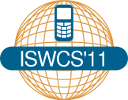Tutorials
All tutorials start at 2pm on November 6th, 2011.
Base Station Cooperation in Cellular Systems
Stephen Hanly - National University of SingaporeBase station cooperation has been part of cellular communications for many years, eg. soft handover in cellular CDMA networks. However, in recent years, research has begun to consider much stronger levels of cooperation, as needed to realize so-called "Network MIMO" where a whole cluster of base stations form a geographically distributed antenna array, jointly beamforming to users distributed across the cluster of cells. Such approaches are indeed under consideration for next generation cellular systems, for example so-called Coordinated Multipoint (CoMP) in 3GPP LTE-Advanced.
There are various levels of cooperation that can be considered, and this tutorial will cover topics ranging from coordinated power control, and dynamic fractional frequency re-use, through to coordinated beamforming, and full network MIMO.
In the simplest interference avoidance strategies, base stations share channel state information in order to improve the optimization of resources such as time-frequency slots, power levels, and antenna beams. We will review schemes such as dynamic fractional frequency re-use, dynamic power control, and coordinated beamforming. In coordinated beamforming, base stations jointly design their beamforming vectors, taking into account shared channel state information. We will cover this topic in detail, including up-link downlink duality, the Lagrangian formulation of this duality, and we will take into account per base station power constraints. Since these optimization problems can look rather complicated, we will show how large systems analysis techniques can simplify the picture and provide structure in the limiting form of the optimal beamformers, as the number of users and number of antennas per base station grow large together. We will then observe how much instantaneous channel information really needs to be shared between the base stations.
If there is sufficient backhaul bandwidth connecting the base stations in the network, user data can be shared between the base stations, and in this case network MIMO becomes possible. We will cover scalable cooperative schemes including Turbo base stations, in which Turbo decoding methods are carried over to the realm of multiple cell processing (MCP). On the uplink, the joint problem of decoding all the mobiles in the cellular network is solved in a distributed way via probabilistic message passing on a graph, where the nodes in the graph represent mobiles and base stations. Uplink-downlink duality can be exploited to similarly obtain a distributed approach to downlink multi-cell beamforming. In this approach, the base stations are locally connected to their neighbours rather than to a central processing site, and coordination is obtained via message passing between adjacent base stations. We will explore issues such as distributed computation, parallelism, complexity and accuracy. The other distributed approach is clustering, whereby joint MCP is accomplished within clusters, and inter-cluster interference occurs between clusters. Finally, we will consider the issue of imperfect and partial channel state information. We will review recent work on transmit beamforming under partially shared channel state information, including the case where the quality of channel state information varies from cell to cell.
Finally, we will survey the state of the art in terms of practical developments, and identify future directions for research.
Polar Codes
Emmanuel Abbe - EPFL, Lausanne, SwitzerlandPolar coding is a method for constructing capacity-achieving codes with low-complexity encoding and decoding algorithms. Polar codes are also applicable to a wide range of other information-theoretic source and channel coding problems. This tutorial offers an introduction to polar coding, and overviews different extensions and applications.
The 3GPP LTE Relaying Solution
Christian Hoymann - Ericsson, GermanyMobile broadband cellular networks provide high data rates and their introduction is already a great success. Their growth will continue and they will provide mobile broadband services even in scenarios with unfavorable radio propagation conditions. In order to cope with such conditions, relaying has been proposed as a cost-efficient solution. By means relay nodes, the radio link between the base station and a terminal is divided into two hops, each with better propagation conditions than the direct link.
Recently ITU’s Radio communication sector has conferred IMT-Advanced Status to 3GPP LTE, whose latest release supports relaying. This tutorial provides an overview of the 3GPP LTE relaying solution. Potential target scenarios are outlined. An overview of the standardization impact related to physical layer as well as architecture and protocols is given. The discussion of simulation results will exemplify the performance of relaying in LTE. At the end, we will give an outlook on potential future enhancements.











